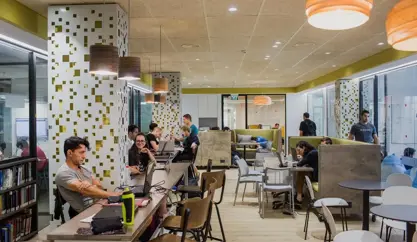Five-unit math is the best predictor of success in academic engineering studies, and for good reason: As it turns out, STEM (science, technology, engineering, mathematics) education is a whole that exceeds the sum of its parts, even in humanities. How is it done?
The ability to predict success is a tricky thing. Yet the accumulated experience of the industry yields important insights on what academia should teach, while the accumulated experience of academia yields insights on high school and all the way back to kindergarten. We’ve understood that while the world outside has changed beyond recognition, the educational continuum from kindergarten to academia has remained more or less the same. To stay relevant – as a technological superpower, a society, and individuals entering the job market – it’s time to wake up and adopt innovative teaching methods.
The Cheshire cat said it well to Alice in Wonderland: If you don’t know where you want to get to, it doesn’t much matter which way you go. Well, where do we want to get to?
“For years academia has operated the same way, but both the industry and youths have changed,” says Alon Barnea, VP of development at Afeka – the Academic College of Engineering in Tel Aviv. “We’ve realized that in order to adapt engineering alumni to the industry’s needs and to equip them with the tools for success, the educational process of engineers/students must itself change. And just as in any high tech development process, academia should start by defining the end-product – the desired image of the alumnus/engineer – and assume responsibility for it." For this purpose, we decided on types of innovative study methods.

“We went on a journey that included extended brainstorming with the industry to try and understand its precise needs and to promote innovative teaching methods in higer education. We surveyed and mapped requirements at over a hundred technology-oriented companies of all sizes, reviewed studies by McKinsey and others, and visited leading academic institutions around the world who started doing this earlier. A wonderful source of inspiration was the process led by ABET, the leading accreditation organization for higher engineering education in the US. There, too, actually at the behest of the industry, they identified the growing gap between needs and abilities in the transition to the job market, and found that skills – not knowledge gaps – were at the top of the list of needs and shortages.”
“Armed with these lessons and data, Afeka’s management sat down to outline the ‘image of the engineering alumnus/alumna’ – a blend of engineering and scientific knowledge, skills, and values. Based on this ideal image, we started an internal process of mapping and change. The insights gleaned from this process contributed to the Afeka Framework – which became our change roadmap, where a key element and the universal common denominator is the approach to and implementation of STEM education and a combination of innovative teaching methods.”



When Math Meets Music
It is necessary to understand what is innovative teaching. “STEM education – an acronym for Science, Technology, Engineering, Mathematics – includes two key trends,” explains Barnea. “Firstly, it’s obvious that these subjects aren’t going to disappear. Even if AI replaces working hands and the human brain in more and more tasks, we’ll still need to unpack issues, design, invent, and tell the essential from the nonessential. Secondly, it turns out that STEM as a way of thinking is also relevant to those who wish to develop in professions that aren’t strictly STEM. There’s lots of educational tracking and fear, with young folks shying away from science. But with the right attitude and access, preferably as soon as grade school, we could have an entirely different perspective.”
As an example of the connection between engineering and a seemingly unrelated subject, Barnea mentions a joint hackathon by Afeka and the Rimon School of Music – and says that anyone who relates to creation, to musical harmony, will find that technology works wonders there. “You can and should expose a boy or girl who loves sports to the wonders of sports tech. That way, we’ll both foster their analytic thinking and open doors for them in the future.”
Another interesting detail discovered at Afeka: It turns out that the single best predictor of success in engineering studies at Afeka College is five-unit math studies in high school, almost regardless of the matriculation score (70 and up). Says Barnea: “The x-factor is itself coping for years with the challenges of mathematical thinking. And that’s exactly the thing about STEM: it’s a cognitive pattern that’s relevant to every field and profession. Certainly when models show us that 65% of today’s first-graders will work in professions that don’t exist yet. We have no idea what their world will look like, but it’s our responsibility to develop their vital skills in preparation for whatever may come. Part of that is training their STEM muscles from a young age.”
Pedagogic Axis, Mental Axis
Mohana Fares, Vice Director General and director of the Administration of Technological Education at the Ministry of Education, adds an important dimension to STEM: “These four letters don’t represent four unrelated subjects, but four subjects that intertwine. Multidisciplinarity, as we in academia say. That is what most development projects are like nowadays.”
As preparation for this world, and based on experiential learning, the Ministry of Education has launched the Jam-Tech program. “We mix teams from multiple technological high school tracks in working on a joint project, such as a quadcopter that can transport food from one place to another. For a product like that, you need content from computer science, AI, physics, math, engineering, and of course the world of design.” Similar multidisciplinary programs also take place at lower grades.

Fares divides the work into two axes: The pedagogic axis, of building curricula and infrastructure, training high-quality principals and teachers, securing mentors, etc.; and the mental axis, of working with the students themselves: how to make them understand that they can, no matter their background or place of residence. “Where there’s people there’s potential,” he says repeatedly. “So yes, we don’t see many representatives from the periphery in the IDF’s 8200 unit, but we need to go back and change this. Put excellent principals and teachers in place, instill the students with a sense of responsibility and capability, and creatively provide them with access to STEM (along with a command of English, a no-less problematic key issue nowadays.) Because STEM is not just, and even not primarily, about knowledge – it’s lots of skills.”
Based on the experience he has accumulated in education from grade 1 to grade 14, including a veritable revolution among the Druze community, Fares also considers STEM education to be a social and national tool of the first order. “STEM isn’t just for the rich, or residents of central Israel, or boys,” he says: “It’s for everyone.”




Innovative Teaching Methods
Share a link using:
https://arabic.afeka.ac.il/en/afeka-news/magazine/innovative-teaching-methods/WhatsApp
Facebook
Twitter
Email
https://arabic.afeka.ac.il/en/afeka-news/magazine/innovative-teaching-methods/